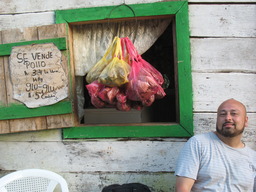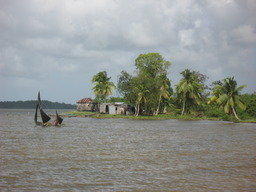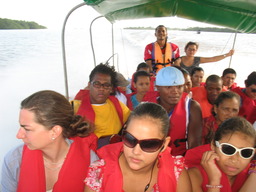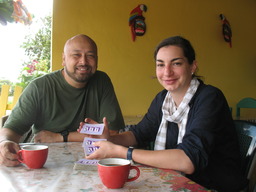
Glu-Glu Break, Kokra Hill
 Glu-Glu Break, Kokra Hill |
A young couple in a canoe paddled up to where Irina was sitting out on the sand. After pulling their boat ashore, the man repeatedly hacked a machete about the green skin of a coconut. Eventually, a small hole was shaven open allowing the juice inside to flow out. Hole-side-up, he offered the coconut to Irina.
I was a short distance off, swimming in the waters of the Caribbean. Irina called out to me. The two from the canoe also waved at me. I waded ashore and was proffered a coconut of my own. The canoe couple spoke no English and didn't attempt to say anything in Spanish. The village whose beach we were enjoying, Awas, is populated by an indigenous people, the Miskito, who have managed to retain their own language.
 Boat Sets Sail, Awas |
So, that's how Irina and I spent this last day of the year--splashing about the Mosquito Coast. We've been based in the village everybody in the area calls "Pearl Lagoon" but all official maps indicate to be "Laguna de Perlas". Today, the main language spoken along most of this stretch of the Caribbean is no longer Miskito--but nor has that been replaced with Spanish. Most people we've interacted with over our past days in the area have been native speakers of English.
 Boat from Bluefields |
The culture here feels West Indian in ways other than the majority of people speaking in Creole. Bars and restaurants here blare reggae rhythms at volumes that can be heard several blocks away. Unexpectedly, the ubiquitous hand-crafted video jukeboxes around town seem to alternate every reggae cut with the next selection as some country/western ballad. That's a genre I had thought was popular strictly within the U.S.--and even there limited only to Southern and rural areas. I don't think I've heard country music played elsewhere in the world.
I might still be in Nicaragua but it feels as-if I'm somewhere very, very far from Latin America.
 Coffee Break, Acoyapa |
We plan to take advantage of our seaside location for a nice final meal of the year. Last night, we happened into Queen Lobster, a thatched hut along the shore that served up the best shrimp cocktail I've ever had. We're going back tonight. Fresh seafood is so ordinary and plentiful here that even going out for shrimp one night and lobster the next doesn't seem an indulgence.
Happy 2012 to all!